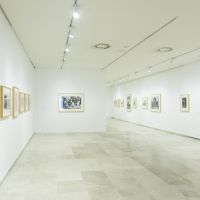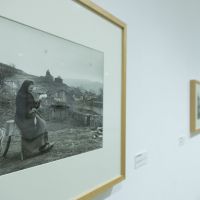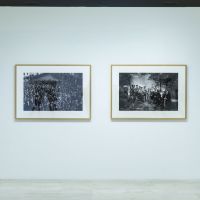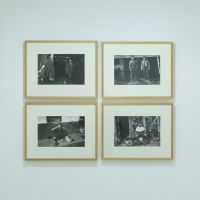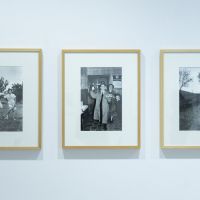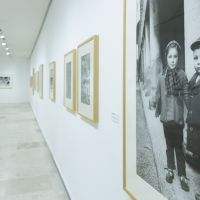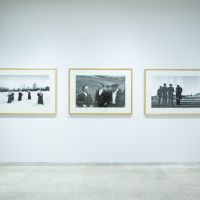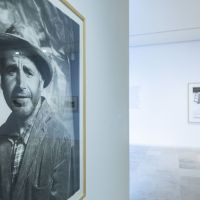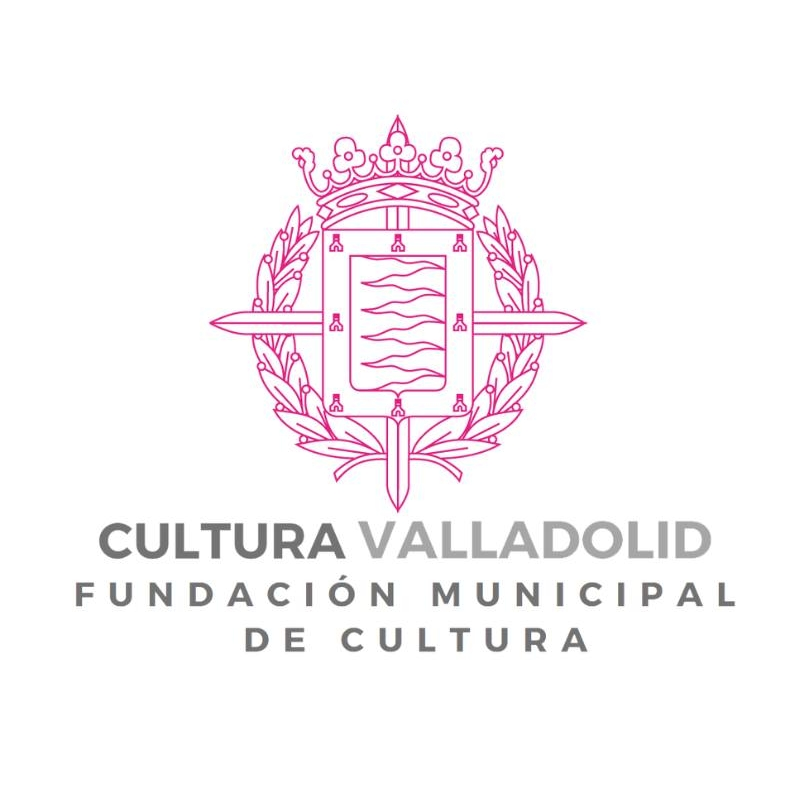PIEDAD ISLA
Un testimonio fotogrÃĄfico

[English version below]
El programa del Museo Patio Herreriano se ha asomado en fechas recientes a una idea de progreso que ha adoptado diferentes formas narrativas y se ha materializado en un amplio arco de disciplinas, como la fotografÃa, el vÃdeo, la escultura o la instalaciÃģn. La mirada crÃtica de Irene de AndrÃĐs en torno al fenÃģmeno del turismo en Ibiza como errÃĄtica visiÃģn del desarrollo econÃģmico; la recuperaciÃģn, por parte de Alejandro S. Garrido, de las barriadas llamadas âCoreaâ y del estigma que vivieron desde su creaciÃģn a principios de los cincuenta, o la reflexiÃģn insobornable de Eva Lootz sobre el progreso asociado al material y al trabajo y las derivas de la colonizaciÃģn son algunos de los asuntos que esta instituciÃģn ha abordado para dar cuenta de las contradicciones y la complejidad de nuestro tiempo y de nuestra historia.
La exposiciÃģn que ahora presentamos en torno a Piedad Isla, que realizÃģ toda su obra en Cervera de Pisuerga y alrededores, acude nuevamente a esa idea de progreso, pero lo hace desde un sentido que no es tan crÃtico como consciente del terreno ambivalente en el que se halla la obra de la fotÃģgrafa palentina, entre el desarrollo y el olvido que ÃĐste trae consigo, pues el carÃĄcter obsolescente de las cosas de las gentes, de sus ajuares, de sus quehaceres, ocupÃģ a Piedad Isla durante toda su vida. Su carrera arranca a principios de los cincuenta, con sus primeras incursiones en el territorio de la fotografÃa en una estancia en Oviedo. El aÃąo 1953 es importante para ella, y tambiÃĐn para el paÃs en el que viviÃģ, pues la economÃa espaÃąola disfrutÃģ entonces de un primer repunte gracias al dinero americano, recordarÃĄn que los barrios llamados âCoreaâ que retratÃģ Alejandro S. Garrido en su exposiciÃģn âCiudad y progresoâ tienen su origen en las ayudas que el gobierno de Eisenhower ofreciÃģ a Franco en los conocidos como Pactos de Madrid. Ese aÃąo, Isla compra una cÃĄmara Kodak con la que empieza a satisfacer, entre otras cosas, las necesidades de las nuevas normativas burocrÃĄticas. FotografÃa tras fotografÃa, Piedad forjÃģ una singular forma de representar su entorno, ya fuera desde lo que el nuevo tiempo demandaba en tÃĐrminos tÃĐcnicos o desde la voluntad de narrar lo vivido. Es por esto que la mirada a la vida cotidiana de Cervera convive en esta exposiciÃģn con su propio trabajo profesional, que consistÃa en retratar a la poblaciÃģn, acudiendo a menudo a procedimientos y medios tÃĐcnicos rudimentarios, como las sÃĄbanas blancas que utilizaba como fondo y que le sitÚan prÃģxima a ese gallego coetÃĄneo que fue Virxilio Vieitez.
El interÃĐs de la fotÃģgrafa en los grupos sociales, en los gremios y, sobre todo, en las franjas generacionales, le llevÃģ a realizar un registro de la vida rural castellana que tiene como mayor virtud la capacidad de deslizarse en el corazÃģn de sus motivos. La distancia entre cÃĄmara y motivo es mÃnima, fruto del hecho irrefutable de que Piedad formaba parte del mundo que retrataba. NiÃąas y niÃąos y hombres y mujeres mayores acapararon una parte importante de su producciÃģn, reflejo no solo de los ritmos vitales sino del fluir del tiempo, de lo que viene y se va, algo que conecta con la posiciÃģn etnogrÃĄfica desde la que observa el mundo y que se materializa en el museo que hoy lleva su nombre, armado en la casa donde viviÃģ. RegistrÃģ las celebraciones populares y los festejos de carÃĄcter religioso; participÃģ de la intimidad de las familias, abriÃģ el objetivo y observÃģ la poblaciÃģn en su totalidad. Tanto en interior como en exterior, el dominio de la composiciÃģn es, como delata el conjunto de fotografÃas que aquà se muestra, sobresaliente. Entre las numerosas vertientes en las que se desarrollÃģ su trabajÃģ destacan tambiÃĐn sus colaboraciones con diferentes medios de comunicaciÃģn, entre ellos el Norte de Castilla, cuyo director, Miguel Delibes, a menudo publicÃģ sus fotografÃas.
Una prueba de la relevancia del trabajo de Piedad Isla es el ya cÃĐlebre el elogio de Cristina GarcÃa Rodero a Piedad Isla cuando afirma que la palentina fue su referente sin saberlo. Isla, ignorÃĄndolo tambiÃĐn, podrÃa insertarse en una tradiciÃģn fotogrÃĄfica que entronca con las prÃĄcticas nacionales e internacionales de posguerra. La modernidad, cuando no radicalidad, con la que Isla se aproxima a la composiciÃģn se aleja de los parÃĄmetros meramente costumbristas y avanza hacia un territorio que encuentra ecos en figuras de la Escuela de Madrid o de focos catalanes diversos. Muchos recordarÃĄn a Gabriel CualladÃģ, cuya obra pudimos ver en estas mismas salas hace ahora dos aÃąos.
Junto a las fotografÃas de Piedad Isla se muestran dos pelÃculas de JosÃĐ Val del Omar realizadas en la dÃĐcada de los treinta del siglo pasado. Desde diferentes perspectivas, el documento antropolÃģgico de Fiestas Sagradas/Fiestas profanas y otra mÃĄs intimista, la âfiligrana amableâ, como llamÃģ GonzÃĄlo SÃĄenz de Buruaga, la deliciosa PelÃcula familiar, con el propio Val del Omar, su mujer y sus hijos como protagonistas. Se establecen asà genealogÃas entre dos figuras distantes en el tiempo y en el espacio, la EspaÃąa republicana en la que tan activo estuvo el cineasta y la EspaÃąa franquista en la que forjÃģ su carrera Piedad Isla.
Piedad Isla
A Photographic Testimony
From 8 May to 19 September
In recent years, the Museo Patio Herrerianoâs programme has reflected upon an idea of progress that has adopted different narrative forms and has materialized in a wide range of disciplines, such as photography, video, sculpture and installation. Irene de AndrÃĐsâ critical view of the phenomenon of tourism in Ibiza as an erratic vision of economic development, Alejandro S. Garridoâs recovery of the so-called âCoreaâ neighbourhoods and the stigma they have experienced since they were built in the early 1950s, and Eva Lootzâs incorruptible reflection on the progress associated with material and labour and the consequences of colonization are just some of the issues that the institution has taken on to try and explain the contradictions and complexity of our times and history.
The exhibition we are now presenting on Piedad Isla, who produced all her work in and around Cervera de Pisuerga, returns to this idea of progress, but does so in a sense that is not so much critical as aware of the ambivalent terrain in which the photographerâs work is to be found, somewhere between development and the oblivion it brings with it, since the obsolescent nature of the things of people, their belongings and their chores, occupied Piedad Isla throughout her life. Her career began in the early 1950s, with her first forays into photography during a stay in Oviedo. 1953 was an important year for her, and also for the country she lived in, as the Spanish economy was enjoying an initial upturn thanks to American money -that the origin of the neighbourhoods known as âKoreaâ and portrayed by Alejandro S. Garrido in his exhibition âCity and Progressâ lies in the aid offered to Franco by the Eisenhower government under what were known as the Madrid Pacts. That same year, Isla bought a Kodak camera with which she began to satisfy, among other things, the needs of the new bureaucratic regulations. Photograph after photograph, Piedad forged a unique way of depicting her surroundings, whether from what the new times demanded in technical terms or from the desire to narrate what she had experienced. This is why Cerveraâs view of everyday life coexists in this exhibition with her own professional work, which consisted of portraying the population, often using rudimentary procedures and technical means, such as the white sheets she used as a backdrop and which place her close to her Galician peer Virxilio Vieitez.
The photographerâs interest in social groups, guilds and, above all, generational strata, led her to record rural life in Castile, the greatest virtue of which is her ability to slip into the heart of her subjects. The distance between camera and subject is minimal, the result of the irrefutable fact that Piedad was part of the world she portrayed. Girls and boys and older men and women made up a significant part of her production, reflecting not only the rhythms of life but also the flow of time, what comes and goes, something that connects with the ethnographic position from which she observes the world and which is materialized in the museum that today bears her name, set up in the house where she lived. She recorded popular celebrations and religious festivities; she took part in the intimacy of families, opened her lens and observed the population as a whole. Both indoors and outdoors, her mastery of composition is, as the group of photographs shown here reveals, outstanding. Among the many areas where she worked, her collaborations with different media also stand out, including the newspaper El Norte de Castilla, whose director, Miguel Delibes, often published her photographs.
Proof of the relevance of Piedad Islaâs work is Cristina GarcÃa Roderoâs now famous encomium for her, when she states that the artist from Palencia was her point of reference, even though she didnât know it at the time. Isla, also unaware of this, could be included in a photographic tradition that connects with national and international post-war practices. The modernity, if not radicalism, with which Isla approaches composition moves away from the merely costumbrist parameters and advances towards a territory that finds echoes in figures from the Madrid School or diverse Catalan focal points. Many will remember Gabriel CualladÃģ, whose work we saw in these same rooms just two years ago.
Together with the photographs by Piedad Isla, two films by JosÃĐ Val del Omar are shown, made in the 1930s. From different perspectives, the anthropological document that is Sacred Festivities/Profane Festivities, and another more intimate one, the âgentle filigreeâ, as GonzÃĄlo SÃĄenz de Buruaga called the delightful Family Film, starring Val del Omar himself with his wife and children. Genealogies are thus established between two figures distant in time and space, the Republican Spain in which the filmmaker was so active and Francoâs Spain in which Piedad Isla forged her career.

